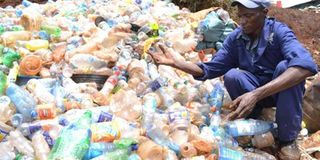Plastics have entered human food chain: study

A man sorts used plastic bottles. Being non-biodegradable, plastics can stay in the environment long after they are disposed of. FILE PHOTO | NATION MEDIA GROUP
What you need to know:
- All eight volunteers in a small pilot study were found to have passed several types of plastic.
- The scientists speculated that the tiny specks may have been ingested via seafood, food wrapping, dust or plastic bottles.
- The two most common were polypropylene (PP) — found in bottle caps, rope and strapping — and polythene terephthalate (PET), present in drinking bottles and textile fibres.
PARIS,
Bits of plastic have been detected in the faeces of people in Europe, Russia and Japan, according to research claiming to show for the first time the widespread presence of plastics in the human food chain.
All eight volunteers in a small pilot study were found to have passed several types of plastic, with an average of 20 micro-particles per 10 grammes of stool, researchers reported Tuesday at a gastroenterology congress in Vienna.
The scientists speculated that the tiny specks — ranging in size from 50 to 500 micrometers — may have been ingested via seafood, food wrapping, dust or plastic bottles. A human hair is roughly 50 to 100 micrometers in width.
“In our laboratory, we were able to detect nine different types of plastics,” said Bettina Liebmann, a researcher at the Federal Environment Agency, which analysed the samples.
The two most common were polypropylene (PP) — found in bottle caps, rope and strapping — and polythene terephthalate (PET), present in drinking bottles and textile fibres.
Together with polystyrene (utensils, cups, coolers) and polythene (plastic bags), they accounted for more than 95 per cent of the particles detected.
“We were unable to establish a reliable connection between nutritional behaviour and exposure to microplastics,” said lead author Philipp Schwabl, a researcher at the Medical University of Vienna.
ANIMAL STUDIES
In earlier studies on animals, the highest concentrations of microplastics were found in the stomach and intestines, but smaller amounts have also been detected in blood, lymph and the liver.
“There are initial indications that microplastics can damage the gastrointestinal tract by promoting inflammatory reactions or absorbing harmful substances,” Schwabl said.
“Further studies are needed to assess the potential dangers of microplastics for humans.”
Schwabl recruited five women and three men, aged 33 to 65, in Finland, the Netherlands, Britain, Italy, Poland, Russia, Japan and Austria.
Each kept a weeklong log of what they ate, and then provided a stool sample.
All consumed foods wrapped in plastic and beverages in plastic bottles, and six ate seafood.
None were vegetarians.
Scientists not involved in the study said it was too limited in scope to draw any firm conclusions, especially about health impacts.
“I’m not at all surprised, or particularly worried by these findings,” commented Alistair Boxall, a professor in environmental science at the University of York in Britain.
For Stephanie Wright, a researcher at King’s College London, the real question is whether plastics are accumulating in the human body.





